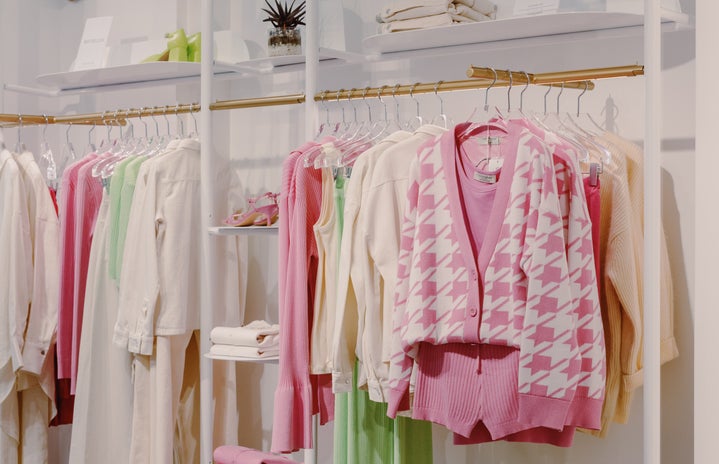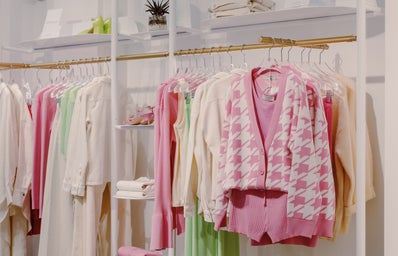As I was in my deep hole of searching online for more clothes that I absolutely don’t need, I came across this little button that said “shop green”. At first I was like, “ew, green isn’t my color, why would that be a tab”, but as I clicked on it out of curiosity, I was presented with eco-friendly clothing options. Sustainability is on the rise in so many industries from tech to agriculture, but it’s important to remember how big of an impact the fashion industry has on this global crisis. In fact, the fashion industry is said to account for 10% of carbon emissions and accounts for about 60 million tons of plastic produced globally every year. When putting this into perspective, it’s key to remember that the clothes that we buy regularly have a huge impact on the global climate issue. With this concern, so many fashion brands – both luxury and retail – have incorporated a sustainable alternative to their products. But these sustainable options led me to two questions: 1) why are these items significantly more expensive, and 2) how costly are these alternatives to the companies that produce them?
Starting with the basics, sustainable fashion is the attempt to have a more “clean” process in developing products. By “clean” they mean using left-over materials to make new products, using better quality textiles instead of ones with microplastics, and just developing without depleting natural resources. Now you might think “why wouldn’t everyone just buy sustainable fashion then?”, but there are a couple of costly factors to consider. First off, society in general is always seeking the cheapest option to buy, which is why sales for fast fashion companies like Shein and Cider have skyrocketed. Sustainable fashion is literally the antithesis of fast fashion: items are way more expensive and don’t damage the environment. Because of the big price difference, only high-income consumers can really afford to purchase these eco-friendly items, since those with lower incomes tend to prize their paycheck and want the most “bang for their buck”. Of course, many people that don’t have the extra spending cash want to help the environment, but the cost of these goods that are equally functional as a cheaper alternative is a huge tradeoff.
So the question remains, why are these products so expensive, and how costly are they for the producers? It really comes down to the materials being used to develop the items. These basic solid colored tees that you were once able to buy for $5 on Amazon now have a more sustainable twin that sells for $30. This gigantic gap in the prices is because the $5 tees are made with some microplastic material bought in bulk from a Chinese factory, whereas the $30 one is created in small batches with ethically sourced cotton. This switch in the type of material, the sourcing, and the production process cause a huge inflation in producer costs. The even scarier piece in this big puzzle is the uncertainty of whether or not these products that companies are pouring their budget into will even be purchased by consumers. Time is also a cost to producers of sustainable fashion, since they are having to work in small batches compared to the rapid production of fast fashion companies. This concept of “slow fashion” works in a way that doesn’t allow producers to take advantage of big economies since small batches of production are always going to be more expensive than making something on a large scale.
It’s important to also note the difference between the feasibility of switching to sustainability in big retail companies like H&M or Zara and luxury companies. Luxury fashion brands from Gucci to Chanel all have this traditional appearance that their brands depend on. With this goal in mind, many luxury producers have a more difficult time making sustainable products, since they need to preserve the essence of the brand through their original materials and process. The easiest example is Louis Vuitton, since they are known for making all of their handbags out of a single piece of fabric. All of the large scraps and trimmed away material then becomes waste and are never recycled. Although the amount of waste that these luxury companies have can be a concern, the idea that all of their products are already made from high-quality sourced materials makes it less dangerous in comparison to waste caused by big retail brands.
The growing popularity of a “responsible retail revolution” is amazing, but does it truly have the power to reverse the damage of fast fashion that has occurred for the past several decades? The only way to encourage the movement of sustainable fashion is to look away from the prices that are a burden to both consumers and producers, and instead view this through an ethical lens. Consumers love a story behind their purchase, because it humanizes the process behind the production of the clothes they wear everyday. It shows the change that they are making both in relation to the global climate crisis, and also in the lives of individuals that handcraft these clean materials. As more and more people lean toward buying more sustainable fashion items, producers will have decreased nervousness about their profits, and eco-friendly alternatives will eventually become the norm.


